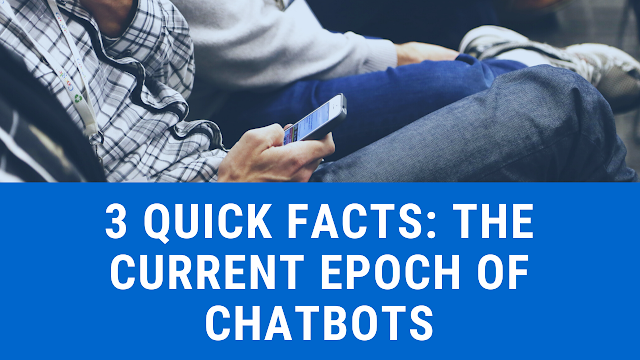3 QUICK FACTS: THE CURRENT EPOCH OF CHATBOTS (7th April 2020)
INTRODUCTION:
The author agrees with this notion “technology is the oil of the 21st Century”, albeit the voice of this statement has already opted to drop out of the presidential race on 11th February.
In fact, the creation of Chatbot supplements this notion. Unless you are averse to technology, chances are you would have heard of Chatbot and the future of e-commerce. Colloquially, a "chatbot" is a computer program that can hold a conversation with a person, usually over the internet. The influence of chatbot is ubiquitous across the board- you can see them in customer services, team communications, sales, and marketing et cetera.
This article seeks to examine just how central Chatbot's role is in the current digital epoch and the proliferation of digital marketing.
This article seeks to examine just how central Chatbot's role is in the current digital epoch and the proliferation of digital marketing.
FACTS: WHY CHATBOTS?
FACT 1: Saves solution time:
Fig. 1: Problems with Traditional Online Experiences. (Source: 2018 State of Chatbots Report)
As can be seen in the report above, one of the few prominent frustrations reported by consumers would be the problems with the navigation of the website (34%) followed by the ability to obtain an answer for a simple question (31%), across all layers or demographics of the customer.
Interface with Chatbot:
Fig. 2: Potential Benefit of Chatbots: Millenials v Baby Boomers (Source: 2018 State of Chatbots Report)
As exhibited in Figure 2, baby boomers were 24% more likely to expect benefits from Chatbots in five of the nine categories.
Hence in view of traditional interface and chatbot, it is not far-fetched to say that the average online experience that of your average website provides no longer matches the latest consumer behavior, regardless of age groups. The pace in which an answer or inquiry can be acquired seems to be the sole determining factor in choosing the Chatbot function- however, it would be equally inadequate to ignore the relevance of the need for interaction with a human operator if the Chatbot doesn't have the answer. A calling customer's primal concern is to solve problem and that is why customers will often call call-centers for human assistance.
a. The Demand for Quicker Solution:
To put it simply, the demand for more pace in solving online problems is there and it would be prudent for marketers alike to tap into this result by incorporating Chatbot in their businesses.
You have probably heard it all- twenty-five percent of customer service and support operations will integrate Virtual Customer Assistant (VCA) or Chatbot technology across engagement channels by2020, up from less than two percent in 2017 and that by 2020, customers will manage 85% of their relationship with the enterprise without interacting with a human.
The velocity of this trend remains to be seen under this unstable sociopolitical climate and the current state of the global pandemic, notwithstanding 2020 has arrived.
b. Chatbot collects data & business intelligence (non-exhaustive):
i. Health and safety:
In this current period of the widespread pandemic, Chatbot has played a major role in matters pertaining to health and safety. It is only befitting to discuss the elephant in the room- how does Chatbot fit into the global picture of the current pandemic? Microsoft did not hesitate in rendering actions.
The synergy between Microsoft and the Centers for Disease Control and Prevention (CDC) involved incorporating Microsoft's HealthcareBot service as a self-screening tool for potential COVID-19 patients.
The recently debuted Bot service, "TheCoronavirus Self-Checker" has made headways in tracking millions of interactions each day.
“Government medical reserves and preparedness, domestic manufacturing and supply lines, perhaps drastic reconsideration of regulatory barriers,” said Desney Tan, who is managing director of Microsoft Healthcare as well as chief technologist at IntuitiveX, a Seattle-based life sciences consulting firm. It does seem like the privacy concern is a general concern amongst users (a topic in which this author will approach near the end of this article below).
ii. Consumer Spending Power:
The life span of an average person has increased by 13% since 1960 and so does his spending power, a leap of 198%. With both entities being directly proportionate to each other, it is only natural to conclude that the human's infatuation for spending is no longer a mere temporary but rather an addiction and a necessity.
In the context of America, 3 ½ hours are spent on their electronics or gadgets each day, for purposes ranging from checking emails, texts, social media updates, and 24/7 news.
An astute digital marketer would be eager to tap into this information. Two of the few most visited shopping website would be Amazon and eBay. It is no secret that digital marketing has a huge impact on consumer behavior- to classify this phenomenon as an unexpected trend that is shortsighted.
Things ranging from phone accessories, smartwatches, grooming products et cetera are amongst the most sought after products. With this stream or trend of consumer purchases, it is only natural for Chatbot to fit right into this equation.
iii. Business intelligence:
One of the easiest ways of collecting data for business intelligence is through Chatbots. Chatbots can collect and analyze data, re-purposes them purposes for other business uses. These two processes are instrumental to the interpretation of big data.
Normally, a Chatbot retrieves data as soon as a customer interacts with it by giving it answers. The more interactions have been carried out, the more a Chatbot would learn. In other words, the Chatbot will then incorporate the previous responses and tailor-make its answer when it replies to another upcoming new customer. The amount of data the system collects and the Chatbot's performances are directly proportionate to each other, as the former will assist in shaping the essential wherewithal of the chatbot.
Furthermore, the system will utilize its natural language processing (NLP) ability to retrieve customers demographics, how the type of languages, sentences, and phrases are used. The amount of information that a developer would be able to extrapolate from these interactions are pivotal in developing customer-centric Chatbots in the future.
All of these refinements in the behavior of the chatbots are impossible without big data. Big data and chatbots together have a lot of potentials that is yet to be tapped into. The future holds some exciting developments for this collaboration and the world is keenly looking forward to optimal customer experience.
FACT 2: Cost-effective:
With an AI utilizing system, an estimated cut of $8 billion in business costs is predicted by the year 2022. Chatbots will see themselves more in online spaces, such as CRMs, intranet, and IT helpdesks.
a. Reduced Operational Costs
Chatbots reduce the number of incoming calls to contact centers, improving efficiency and reducing operational costs by providing immediate answers to immediate customer queries (albeit basic).
The overall interaction volume – including chats, emails, and social media inquiries can be greatly reduced. This is especially true for phone assistance. According to VentureBeat, “Even if a person makes a ‘call me’ command to connect with a live agent after initiating a Chatbot interaction, a contact center pays about 33 percent less for outbound calls than inbound calls.” Each time a customer interacts with a Chatbot before a live person, the cost per query gets lower.
A quicker resolution for customers results in a lower cost-per-interaction for companies, and better use of agents’ paid time.
b. Lower Labor Expenses
Enterprises often resort to reduce staff numbers in hopes of reducing labor expenses. Inversely, businesses that reduce their agent count to save money often find the number of calls and chats in their queue skyrocketing. This practice often backfires as all it does is reduce staff numbers but not at all on the ratio of staff per call. This results in longer calls per customers and actually costing more on the phone bills, which in turn results in lower customer satisfaction.
Chatbots can handle an unlimited amount of interactions simultaneously compared to an average live chat member. A quality Chatbot often costs less than the annual salary of a single employee, even after initial installation and programming costs (consider the costs of hiring, onboarding, training, hourly pay, and benefits per agent).
c. Cheap, 24/7 availability
Chatbots cost the same whether they’re available 24/7, three hundred and sixty-five days per year or not. By letting Chatbots handle after-hour queries, companies can provide customers with the support that they need – when they need it – without having to hire additional agents to cover these odd working hours.
As of figure 3 below, US Digital Internet User prefers the voice call feature(29%). Regardless, there are 26% who preferred online chat or 3% who preferred messaging apps (3%) like Facebook Messenger or WhatsApp:
Fig. 3: US Internet Users' Preferred Method of Contact with a Digital Retailer While Making a Purchase. (Source: https://www.emarketer.com/Article/Chatbots-Akin-Real-Life-Customer-Service/1015022)
d. Return on Investment
Allowing a Chatbot to handle simple, repetitive queries takes this burden off agents and helps them to develop their skills by only taking on the queries that really test the limits of their knowledge. This leads to a happier, more fulfilling experience for the call agent or operator.
Naturally, fulfilled agents have a lower turnover rate, meaning that companies don’t have to invest as much time and resources in recruiting, hiring, training, and onboarding new agents. The costs on this can then be allocated to other parts of the enterprise or company.
FACT 3: LEGAL CONCERNS:
Picking up the point on the aforementioned role of Microsoft's bot in assisting the tracking and screening of COVID-19 in the The US, the underlying concern seems to be on personal data privacy. “This turns out to be a really tricky one, with much debate within Microsoft, within various levels of government and within our communities,” Tan concedes.
a. In the context of Malaysia:
Issues on data protection have been in prevalence not only in Europe but also in Asia(in the context of Malaysia, ASEAN). In Malaysia's context, the Personal Data Protection Department (PDPD); an agency under the Ministry of Communications and Multimedia Commission (MCMC) in 26th May 2011 after the passing of the Personal Data Protection Act 2010 (PDPA)); has been the bulwark of data protection in Malaysia.
Few of the main protections provided under the PDPA are (non-exhaustive), among others as set out colloquially below:
Few of the main protections provided under the PDPA are (non-exhaustive), among others as set out colloquially below:
1. S.7 requires that data user to serve a notice to the data subjects on how their personal data will be processed by the data user; and
2 2. S.8 provides that under no circumstances shall the personal data be disclosed for any purpose other than the purpose for which the personal data was to disclose or to any party that is not privy to the contract; and
3 3. S.9 requires that data users to take practical steps to protect the personal data from any loss, misuse, modification, unauthorized or accidental access or disclosure, alteration, or destruction.
Furthermore, s.38 also provides revenues for data subjects to withdraw their consent.
b. What does this mean to data users such as Chatbots?
Any party who is in contravention of these sections will be liable to a fine ranging from RM 10,000 to RM 50,000 or imprisonment for not more than 6 months, or both. These mechanisms in place would serve as a check and balance concerning any offenses or liability incurred by any party.
CONCLUSION:
To round this up, there are a plethora of reasons that exhibit Chatbot as a pivotal gearwheel in the current epoch of digital marketing. Experts share the same sentiment on the roles of Chatbot. With this being said, it would be equally inadequate to suggest businesses to completely abandon human-to-human interaction:
Fig. 4: Potential Blockers to Using Chatbots: What would stop you from using a chatbot? (Source: 2018 State of Chatbots Report)
As exhibited above, there are concerns about the functionality of chatbots in delivering the correct response needed. A general distrust or averseness, developers or users alike would agree that with the technology still has room for improvement and also an infinite potential for development.
A business doesn’t always need to be put in an "either and or" situation. Perhaps the best way forward would be to combine online chat with a chatbot, with the latter to step in for the former in assisting the customers to not let response time suffer. This is because detailed and more complex questions might necessitate a rather friendly human interaction to ensure the problem can be resolved adequately.
Further, the Malaysia government's drive to Advanced technology is reflected by the government's setting up of the PDPD. Albeit novel, business enterprises and customers do enjoy protection under PDPA, with laws on privacy being put in place to safeguard any legal liability that could potentially arise in the process.
The advancements of Chatbots and AI show no signs of slowing down as they poise to be the new apps. In fact, Malaysia has seen a proliferation of enterprises integrating both entities in the day to day running of their operations and businesses. In return, this situation should present itself as a fortuity and not a scourge for business and customers alike, as both parties seek to procure a smoother B2B and B2C interactions.
More on CRM, Chatbots, AI and automation? You will be interested in this:
Check out Rocketbot. Try now for free.
More on CRM, Chatbots, AI and automation? You will be interested in this:
Check out Rocketbot. Try now for free.







Comments
Post a Comment